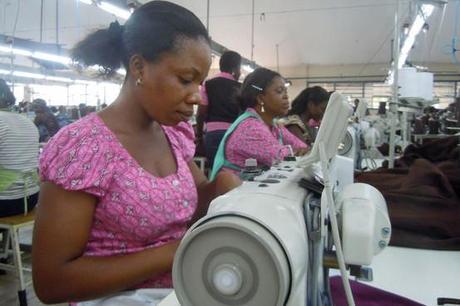
A growing textile industry is among the drivers of Ghana’s rapid economic growth in recent years. (Photo: Wall Street Journal.)
By Chris Braddock
Next week the U.S.-Africa Leaders Summit will bring approximately 50 heads of state to Washington, DC, for the purpose of discussing trade and investment in Africa and highlighting America’s commitment to the continent. During a recent trip in the region, I spent quite a bit of time thinking about this topic.
Over the past four months I was busy traveling in sub-Saharan Africa (SSA), meeting with businesses and academics and researching the business opportunities in five different countries. As part of this trip I had the opportunity to meet with several CIPE partners and consultants who, as representatives of the private sector, were able to speak about the enabling environment and some of the challenges and opportunities of businesses working in SSA.
Most countries in SSA have historically been seen as too unstable, too small a market, or too risky for U.S. companies to explore opportunities, so there are few American companies operating in the region. The perception of SSA for many is based on the plethora of negative stories presented by the media, but this is merely a small and decreasingly significant part of the SSA story. Growth rates are high, people are optimistic with larger disposable incomes, and foreign direct investment is flowing in larger quantities, particularly from Asia. U.S. firms are starting to get left behind.
In 2013, SSA had a combined GDP of $1.63 trillion and is growing rapidly. To put that into perspective, the U.S. GDP in 2013 was $16.8 trillion, China’s $9.2 trillion, India’s $1.9 trillion, Malaysia’s $312 billion, and Thailand’s $387 billion. The population of SSA is 937 million and also growing rapidly, compared to 316 million in the United States, 1.4 billion in China, and 507 million in the European Union countries (World Bank data).
U.S. companies should not miss out on SSA, since the “first mover” principle is particularly strong in the region. Companies that are first to the market and build awareness, brand recognition, and relationships throughout supply chains have a tremendous advantage, arguably more so than in any other region of the world.
SSA is full of contradictions and frustrations, but as long as individuals and companies embrace them and work through them, SSA can be a thrilling, dynamic, and rewarding place to do business. SSA is not a place for every company or every business model or every product, but it is a place that all companies should start exploring for opportunities — even if the ultimate decision may be to hold off and focus resources elsewhere.
There are tremendous opportunities and tremendous risks in SSA, so companies do need to understand the risks and work to mitigate them as much as possible. The risks, however, should not be overplayed or sensationalized as they often are, because that is what irrationally keeps many companies out of SSA. The upside of this is that since many companies, particularly U.S. firms, are still hesitant about SSA, the companies that are willing to explore the opportunities have reduced competition.
This can be an advantage, because U.S. companies and products are seen as premium products with guaranteed quality across SSA. While not the case for every product or service, there are many times that companies and consumers will be willing to pay a slight premium for a U.S. product or service because of their perception that if it is from the United States it is guaranteed to be high-quality, particularly relative to Chinese products or services. U.S. companies are trusted and they need to understand how to leverage this significant competitive advantage across the continent.
There are already numerous U.S. multinational firms operating, many expanding recently, across SSA. I think the main untapped opportunity is for U.S. small and medium size enterprises (SMEs) doing business in SSA. The positive aspects about SSA hold for the large companies as well, but U.S. SMEs frequently have products and solutions that would be valued in SSA, but are not aware of opportunities and markets there or are unable to tap them. Another advantage that SMEs have over large, billion-dollar corporations is that market size is less of a concern. Multinational corporations need sizable markets to make it worth their investment, while SMEs do not need nearly the same market size to justify entering a country or region.
The upside potential for U.S. companies in SSA is enormous, the risk can be managed and mitigated, and SSA companies and SSA governments are increasingly looking abroad for investment, partners, expertise, and quality products and services. U.S. companies need to be aware and ready to respond to those needs and opportunities or be prepared to be left behind in the fastest growing region in the world.
Chris Braddock is president of SkyPatrick Global Services.

